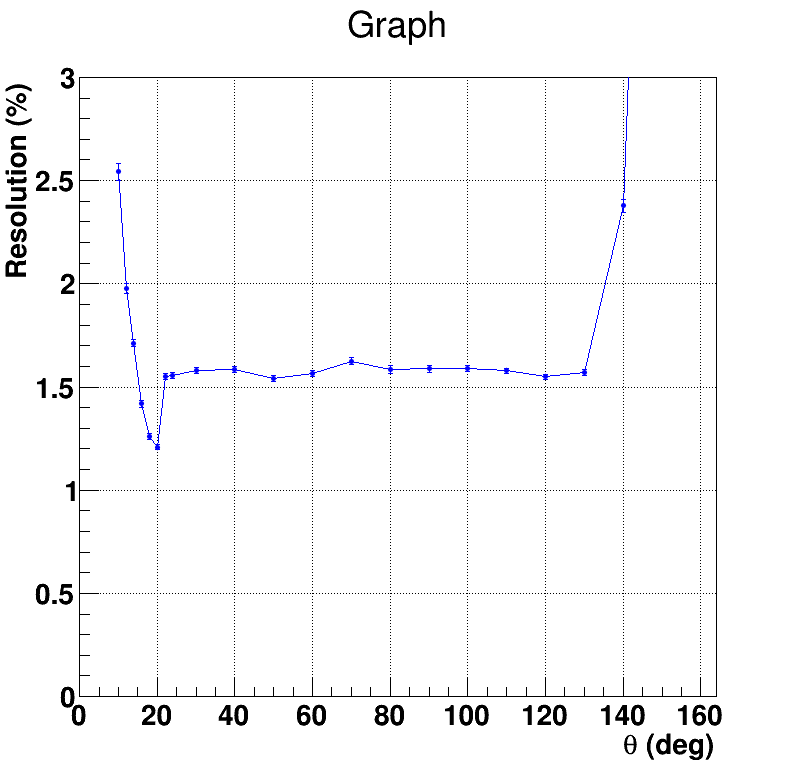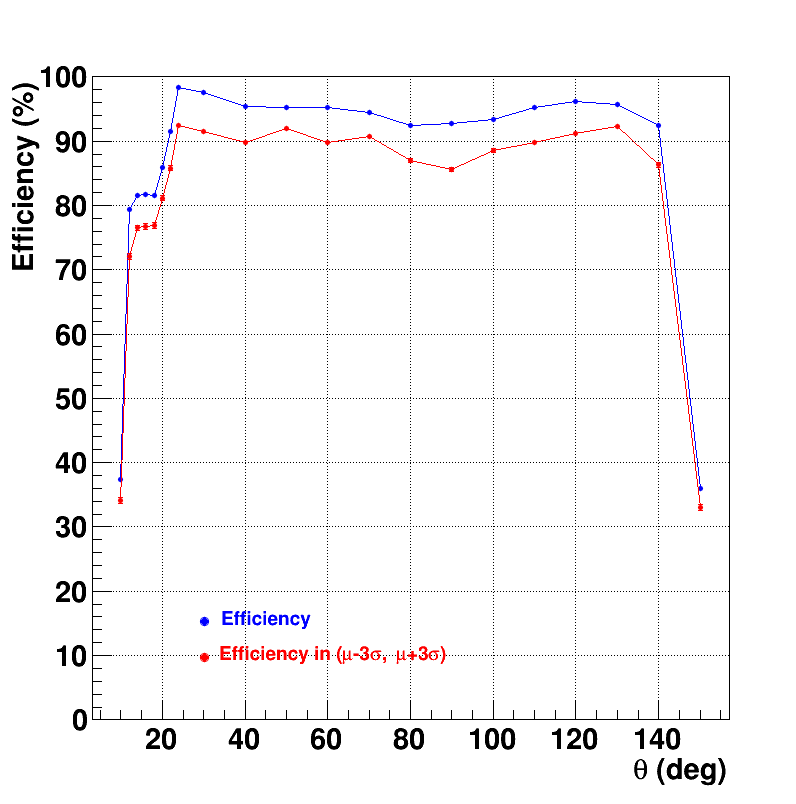Home » PANDA » PandaRoot » Tracking » Tracking efficiency release/jan14
|
|
| Re: Tracking efficiency release/jan14 [message #15897 is a reply to message #15896] |
Mon, 24 February 2014 16:10   |
 MartinJGaluska
MartinJGaluska
Messages: 203
Registered: March 2010
Location: Germany
|
first-grade participant |
From: *physik.uni-giessen.de
|
|
Hello Klaus,
I have just noticed that you seem to have included the very forward part to calculate the average tracking efficencies. One reason that the average efficiency might be measured lower than with previous versions of PandaRoot is a change in the FTS ideal tracking which leads to lower efficencies in the theta range 5⁰ to 12⁰ or so.
I have changed the standard behavior of the FTS ideal tracking to make it behave more realistically by requiring a track found by the FTS tracking to have at least 5 FTS hits (compare to https://forum.gsi.de/index.php?t=msg&goto=15518). Previously, the FTS ideal tracker "found" all tracks that had at least 1 hit in the FTS.
As I said, from the FTS tracking point of view that behavior is more realisitic. However, currently there is only a tracking starting from STT + MVD and from FTS in the code. Both tracking algorithms find mostly distinct sets of tracks so that a merge is easily done. Hits from GEM are only added to tracks found by FTS and by STT + MVD, but there is no tracking starting from GEM being used in the current version of the code.
I was made aware of the drop in efficiency by Donghee in December and as a workaround implemented PndFtsTrackerIdeal::SetMinFtsHitsPerTrack(int); to set the number back to 1 to have an overall detector performance that is similar to before the changes in the FTS ideal tracking. However, I did not change the default value of requiring at least 5 FTS hits.
I have just changed the default value to 1 to avoid possible problems and confusion, especially when the simulation campaigns will be executed and new results will be compared with old ones. At this point I suggest to use the value of 5 for standalone performance studies of the FTS only.
Maybe that was one factor that your efficiencies look worse than before, but in your talk this morning it seemed that the efficencies for the barrel part 22⁰<theta<140⁰ were also affected (which is most probably not due to any FTS ideal tracking changes).
Kind regards,
Martin
[Updated on: Mon, 24 February 2014 16:17] Report message to a moderator |
|
|
|
|
|
| Re: Tracking efficiency release/jan14 [message #15913 is a reply to message #15900] |
Tue, 04 March 2014 12:50   |
 Susanna Costanza
Susanna Costanza
Messages: 33
Registered: January 2008
Location: Pavia
|
continuous participant |
From: *pv.infn.it
|
|
Dear all,
I've reproduced (part of) the studies I've done for the TDR.
In particular, I've simulated different sets of 10000 muon single track events, generated at the I.P., with phi in (0., 360.) deg. The theta angular range has been scanned as follows:
- theta = 10, 12, ..., 24 deg in steps of 2 deg (+/- 1 deg)
- theta = 30, 40, ..., 150 deg in steps of 10 deg (+/-5 deg).
The events have been reconstructed (considering only the barrel detectors, not the ones in the forward region) and the Kalman fit has been performed only once; the tracks have then been back propagated with the PndPidCorrelator.
The momentum distributions have been fitted with a Gauss function in the range (mu-3sigma, mu+3sigma), as in the TDR.
The efficiency is calculated as the histogram integral divided by the number of generated tracks (blue curve). The red curve represents the efficiency "in peak", i.e. the number of tracks in the fitted range with respect to the total number of tracks (as in the TDR).
The results are shown in the two plots that are attached to the message: the results are comparable to the TDR ones.
Best regards,
Susanna
 
|
|
|
|
|
|
| Re: Tracking efficiency release/jan14 [message #15930 is a reply to message #15929] |
Thu, 06 March 2014 18:11  |
 Susanna Costanza
Susanna Costanza
Messages: 33
Registered: January 2008
Location: Pavia
|
continuous participant |
From: *pv.infn.it
|
|
Dear Klaus,
sorry, I forgot to mention the particle momentum: it is 1 GeV/c (total momentum).
I used the jan14 pandaroot release (with apr13 external packages) and the macros in macro/run, up to the pid_complete.C macro. Then I used the information stored in the PidChargedCand branch.
Best regards,
Susanna
|
|
|
|
Goto Forum:
Current Time: Mon Dec 08 06:08:08 CET 2025
Total time taken to generate the page: 0.00753 seconds
|
 GSI Forum
GSI Forum


